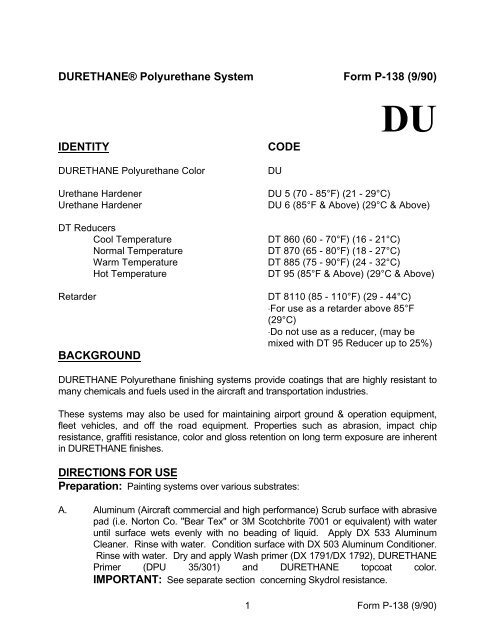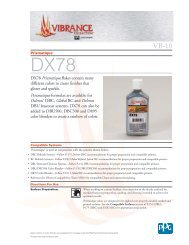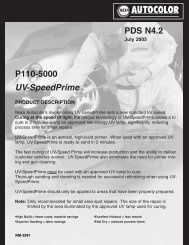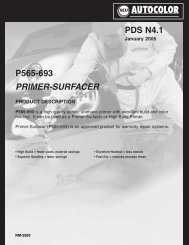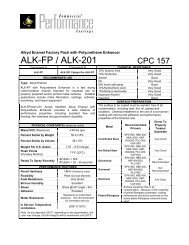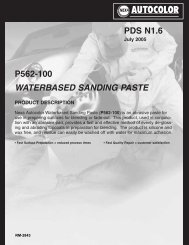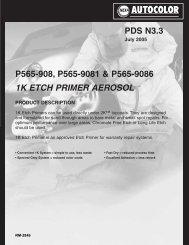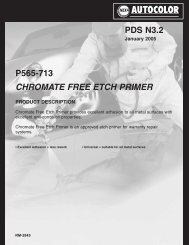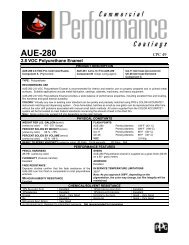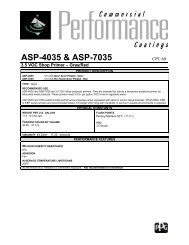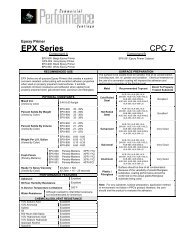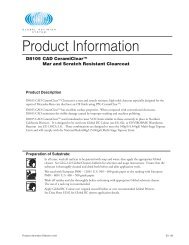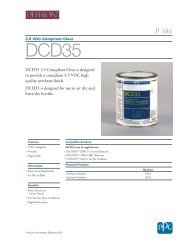DURETHANE® Polyurethane System Form P-138 (9/90 ... - BAPS
DURETHANE® Polyurethane System Form P-138 (9/90 ... - BAPS
DURETHANE® Polyurethane System Form P-138 (9/90 ... - BAPS
Create successful ePaper yourself
Turn your PDF publications into a flip-book with our unique Google optimized e-Paper software.
DURETHANE® <strong>Polyurethane</strong> <strong>System</strong> <strong>Form</strong> P-<strong>138</strong> (9/<strong>90</strong>)<br />
DU<br />
IDENTITY<br />
DURETHANE <strong>Polyurethane</strong> Color<br />
Urethane Hardener<br />
Urethane Hardener<br />
DT Reducers<br />
Cool Temperature<br />
Normal Temperature<br />
Warm Temperature<br />
Hot Temperature<br />
Retarder<br />
BACKGROUND<br />
CODE<br />
DU<br />
DU 5 (70 - 85°F) (21 - 29°C)<br />
DU 6 (85°F & Above) (29°C & Above)<br />
DT 860 (60 - 70°F) (16 - 21°C)<br />
DT 870 (65 - 80°F) (18 - 27°C)<br />
DT 885 (75 - <strong>90</strong>°F) (24 - 32°C)<br />
DT 95 (85°F & Above) (29°C & Above)<br />
DT 8110 (85 - 110°F) (29 - 44°C)<br />
⋅For use as a retarder above 85°F<br />
(29°C)<br />
⋅Do not use as a reducer, (may be<br />
mixed with DT 95 Reducer up to 25%)<br />
DURETHANE <strong>Polyurethane</strong> finishing systems provide coatings that are highly resistant to<br />
many chemicals and fuels used in the aircraft and transportation industries.<br />
These systems may also be used for maintaining airport ground & operation equipment,<br />
fleet vehicles, and off the road equipment. Properties such as abrasion, impact chip<br />
resistance, graffiti resistance, color and gloss retention on long term exposure are inherent<br />
in DURETHANE finishes.<br />
DIRECTIONS FOR USE<br />
Preparation: Painting systems over various substrates:<br />
A. Aluminum (Aircraft commercial and high performance) Scrub surface with abrasive<br />
pad (i.e. Norton Co. "Bear Tex" or 3M Scotchbrite 7001 or equivalent) with water<br />
until surface wets evenly with no beading of liquid. Apply DX 533 Aluminum<br />
Cleaner. Rinse with water. Condition surface with DX 503 Aluminum Conditioner.<br />
Rinse with water. Dry and apply Wash primer (DX 1791/DX 1792), DURETHANE<br />
Primer (DPU 35/301) and DURETHANE topcoat color.<br />
IMPORTANT: See separate section concerning Skydrol resistance.<br />
1 <strong>Form</strong> P-<strong>138</strong> (9/<strong>90</strong>)
B. Aluminum (General Aviation Aircraft, truck bodies and misc) Apply DX 533<br />
Aluminum Cleaner. Rinse with water. Condition surface with DX 503 Aluminum<br />
Conditioner. Rinse with water. Dry and apply DP Epoxy Primer/401 Catalyst and<br />
DURETHANE® topcoat color.<br />
C. Cold rolled steel or steel plate (with little or no rust or mil scale). Treat surface with<br />
DX 579 Metal Cleaner. Rinse with water. Apply DX 520 Metal Conditioner. Rinse<br />
with water. Dry and apply DP Epoxy Primer/401 Catalyst and DURETHANE<br />
topcoat color.<br />
D. Cold Rolled Steel or Steel Plate (with heavy rusting or mil scale). Sand blast<br />
surface to gray metal. Blow off dust with clean compressed air. Clean with<br />
ACRYLI-CLEAN® Wax and Grease Remover (DX 330). Apply DP Epoxy<br />
Primer/401 Catalyst and DURETHANE topcoat color.<br />
E. Old DURETHANE, Epoxy, or other catalyzed finishes. Wash with ACRYLI-CLEAN<br />
Wax and Grease Remover (DX 330). Sand thoroughly with 220 grit or finer DA or<br />
320-400 wet or dry. Reclean surfaces. Apply DURETHANE Primer (DPU 35/301)<br />
or DP Epoxy Primer/401 Catalyst, then topcoat with DURETHANE color.<br />
F. Fiberglass. New molded parts should be washed with a clean cloth liberally<br />
soaked with alcohol. Dry with clean white cloths. Wash thoroughly with<br />
ACRYLI-CLEAN Wax and Grease Remover (DX 330). Lightly sand to remove all<br />
gloss with 320 grit or finer. Avoid sanding through gelcoat - make sure<br />
fiberglass strands are not showing. Reclean surface. Apply DP Epoxy Primer/401<br />
Catalyst and DURETHANE topcoat color.<br />
Mixing: Mix DU Colors thoroughly with the appropriate DT Reducer and DU Hardener<br />
best suited for shop conditions using the following ratios:<br />
DU 5 or DU 6<br />
DU Color DT Reducer Hardener<br />
Solid Colors 1 gallon 2-3 quarts 1 gallon<br />
Metallic Colors 1 gallon 3-4 quarts 1 gallon<br />
Application and Dry Times:<br />
×Set air pressure for 45 - 50 lbs. at the gun when using a siphon feed gun.<br />
×Apply 2-3 full wet coats.<br />
×Allow 15 to 20 minutes tack time between coats.<br />
×Allow the final coat to air dry at normal temperature (75°F/24°C) for 16 hours or force dry<br />
for 50 minutes @ 160°F (71°C).<br />
2 <strong>Form</strong> P-<strong>138</strong> (9/<strong>90</strong>)
Application of Second Color (Two-Toning):<br />
If a second color is to be applied, allow the first color to air dry a minimum of 8 hours at<br />
normal conditions (75°F/24°C) before taping. Tape time may be reduced to approximately<br />
4 hours with the use of DXR 81 Accelerator additive in the first color at the rate of 1 fluid<br />
ounce per gallon of ready to spray DURETHANE® Color. Caution! This will also reduce<br />
the sprayable pot life to 4 hours at normal temperature of 75°F (24°C).<br />
Clearcoating (DU 1000):<br />
For an extra high gloss glamour appearance, DURETHANE colors may be clearcoated with<br />
DU 1000 clear topcoat. Allow the DU solid color to dry a minimum of 20 minutes and DU<br />
metallic colors to dry a minimum of 2 hours, but no longer than 1 week before applying DU<br />
1000 Clearcoat.<br />
Mix one part DU 1000 with ½ part of DT Reducer and 1 part DU 5 or DU 6 Hardener<br />
(1:½:1). Apply two full wet coats using 50 PSI at the gun with approximately 30 minutes<br />
tack time between coats but within 2 hours. If tack time exceeds two hours, allow the final<br />
coat to dry overnight. Example:<br />
Recoating:<br />
DU 1000 DT Reducer DU 5 or DU 6<br />
1 part ½ part 1 part<br />
or or or<br />
4 quarts 2 quarts 4 quarts<br />
DURETHANE may be recoated with itself after curing for a minimum of 8 hours @ 75°F<br />
(24°C) or a maximum of 1 week. After 1 week, scuff sand with 320 - 400 wet or dry, reclean<br />
with DX 330, and reapply DU Color.<br />
Flexible Substrates:<br />
No flexible additive is necessary when applying DURETHANE Color over most flexible<br />
substrates.<br />
Additives:<br />
DX 77 Fisheye Preventor: Surfaces to be painted must be thoroughly cleaned and<br />
prepared. The use of DX 77 is not recommended unless absolutely necessary. Flowout is<br />
decreased in direct proportion to the amount of preventor used. When necessary, DX 77<br />
may be used in a ratio of 1 to 2 screw capfuls per sprayable quart of DU Color.<br />
DXR 81 Accelerator: Accelerators are used to speed up the tape and dry times or to help<br />
when two-toning. The dry time of DU Color may be accelerated with DXR 81 by using up to<br />
½ ounce per sprayable quart or 2 ounces per sprayable gallon.<br />
3 <strong>Form</strong> P-<strong>138</strong> (9/<strong>90</strong>)
Caution: The use of DXR 81 Accelerator will result in shorter pot life and as the amount<br />
of DXR 81 is increased, the degree of gloss is decreased.<br />
Flattening Agent for Durethane:<br />
Use Flattening Agent (DX 685) DURETHANE® <strong>Polyurethane</strong> as specified in the chart<br />
below:<br />
DU Color or Clear 60° Gloss Meter DX 685 DU Hardener<br />
32 oz. Flat 0-5° 42 oz. 32 oz.<br />
32 oz. Eggshell 20-30° 37 oz. 32 oz.<br />
32 oz. Semi-gloss 50-60° 30 oz. 32 oz.<br />
When DX 685 is added, no reducer is needed in this system.<br />
Note: The amount of film build and application procedure can affect the gloss level.<br />
Skydrol Resistance:<br />
When resistance to Skydrol Hydraulic fluid and other extremely harsh chemicals is<br />
required, such as commercial and high performance aircraft and certain chemical<br />
haulers, the DXU 7<strong>90</strong> Activator used in the DURETHANE intermix color formulation<br />
must be replaced on an equal weight basis with DXU 789 Activator. NOTE: This<br />
applies only to solid colors. DXU 789 Activator should never be used in metallic<br />
formulations.<br />
SPRAY EQUIPMENT<br />
Tests have shown these finishes to be versatile with pressure feed, airless, siphon<br />
feed, and HVLP spray gun systems. Whatever application method is used, it is<br />
recommended that a test panel be used to adjust the equipment to assure that proper<br />
atomization of material is attained.<br />
Suggested starting points for air pressure adjustments are:<br />
Pressure Pot <strong>System</strong>:<br />
Siphon <strong>System</strong>:<br />
Airless <strong>System</strong>:<br />
HVLP <strong>System</strong>s:<br />
8 lbs. at pot<br />
45 lbs. at the gun<br />
45 - 50 lbs. at the gun<br />
30 - 40 lbs. on a 25 -1 pump pressure<br />
gauge<br />
0.013 orifice tip<br />
15" fan<br />
10 lbs. max atomizing air at tip<br />
4 <strong>Form</strong> P-<strong>138</strong> (9/<strong>90</strong>)
ACCUSPRAY,<br />
Model 10 Series Fluid Tip #36; Air Cap #10<br />
BINKS, HVLP Mach I<br />
Fluid Tip #94 (.055") Air Cap #95 P<br />
CSI, Softair Fluid Tip #4; Air Cap #4<br />
DEVILBISS, JGHV 501<br />
<strong>System</strong> 1151 Fluid Tip FY (.039"); Air Cap #14<br />
HVLP, HVLP 5000 Fluid Tip 5100 - 12; Air Cap 5004 - 07<br />
MATTSON, LP - 88 Fluid Tip #3 Cartridge N032 Blk. Ring; #3<br />
Air Cap 3 - 5 PSI, cup pressure 5 - 7 PSI<br />
High production #4 cartridge N040 Gld.Ring<br />
Equipment Cleaning:<br />
Use only DT Reducers, DTL Acrylic Lacquer Thinners or Methyl Ethyl Ketone (MEK) for<br />
clean up of spray guns, lines, and equipment. Cleaning should be done immediately<br />
after use to prevent the possibility of material gelling in the equipment. Keep<br />
containers tightly closed when not in use. Hardeners, in particular, will react with<br />
atmospheric moisture.<br />
COMPATIBLE UNDERCOATS: DURETHANE® (DU) may be used over:<br />
DP Epoxy Primers/401 Catalyst<br />
DURETHANE (DPU 35/301) Primer/Hardener<br />
DPE 1538 Zinc Chromate Primer<br />
DPE 656, 1202, 1338 Synthetic Primers<br />
DPX 844 Elastomeric Primer<br />
ROADGUARD® (DX 54)<br />
DX 1791/1792 Wash Primer<br />
*K 200/K 201 Acrylic Urethane Primer Surfacer<br />
*K 36/K 201 Acrylic Urethane Primer Surfacer<br />
*NCT® NCP 250/NCX 255 Primer Surfacer<br />
*Must be sealed with DP Epoxy reduced as a sealer, KTS 30 2K Sealer, or DPU<br />
35/301.<br />
INCOMPATIBLE UNDERCOATS: DURETHANE may not be used over:<br />
SEALER 70 (DL 1970) Primer Sealer<br />
DEL-SEAL® (DAS 1980 or DAS 1987) Acrylic Sealers<br />
DZL 32, 34, 72 Lacquer Primer Surfacers<br />
KONDAR® (DZ 3 or 7) Acrylic Primer Surfacers<br />
DPX 800 Polypropylene Primer<br />
DFL Putties<br />
DSX 1<strong>90</strong>0 Bonding Clear<br />
5 <strong>Form</strong> P-<strong>138</strong> (9/<strong>90</strong>)
Cautions:<br />
DURETHANE® system products are designed to work best at temperatures between<br />
70 - 85°F (21 - 29°C). Painted objects should be dried at no lower than 60°F (15°C) for<br />
the first 24 hours. Do not return catalyzed material to partly full original containers,<br />
since these products have a pot life.<br />
Do not use DU 4 Hardener in Durethane Color systems.<br />
TEST PROPERTIES<br />
VOC (Unreduced Color)<br />
3.9 to 4.4 #/U.S. gal<br />
VOC (Ready to Spray) (1:½:1) 4.6 to 4.8 #/U.S. gal<br />
Application Viscosity (#2 Zahn)<br />
15 - 20 Seconds<br />
Total Solids by Volume (Average) (1:1:1) 36%<br />
Total Solids by Weight (Average) (1:3/4:1) 37%<br />
Square Foot Coverage (1 mil @<br />
575 sq. ft. #/U.S. gal.<br />
100% transfer efficiency)<br />
Recommended Dry Film Build<br />
2.0 to 2.5 mils<br />
Recommended Wet Film Build<br />
4 to 5 mils<br />
Recommended Wet Film Build Per Coat<br />
2 to 2.5 mils<br />
Sprayable Pot Life @ 75°F (24°C)<br />
5 to 6 hours<br />
Flash Point (PMCC)<br />
70°F (21°C)<br />
Tack Time Between Coats<br />
15 to 20 minutes<br />
Air Dry Recommendation<br />
16 hours<br />
Bake Schedule<br />
40 - 50 minutes @ 160°F (71°C)<br />
Dust Free Time<br />
45 minutes<br />
Tack Free Time<br />
3 hours<br />
Tape Free Time<br />
8 hours<br />
Recoat Time<br />
8 hours<br />
Gloss (20 degrees) <strong>90</strong> +<br />
Pencil Hardness<br />
2 H min.<br />
Test Results<br />
Test Result Comments<br />
Specular Gloss<br />
60 degrees 95<br />
20 degrees <strong>90</strong><br />
Accelerated Weathering<br />
ASTM G-23, 500 hrs<br />
Film Failure<br />
None<br />
Gloss Retention<br />
60 degrees <strong>90</strong>%<br />
20 degrees 88%<br />
6 <strong>Form</strong> P-<strong>138</strong> (9/<strong>90</strong>)
Test Results Cont.<br />
Test Result Comments<br />
ASTM G-53, 500 hrs.<br />
Film Failure<br />
None<br />
Gloss Retention<br />
60 degrees 98%<br />
20 degrees 98%<br />
Solvent Resistance<br />
25 Double Rubs No Effect<br />
Pencil Hardness<br />
Resistance to Cycles<br />
of cold and heat<br />
High Temp Resistance<br />
3H<br />
No cracking, etc.<br />
No blisters, etc.<br />
Impact Resistance 140 in/lbs Passed<br />
60 in/lbs Passed<br />
Corrosion Resistance
Test Results Cont.<br />
Test Result Comments<br />
GM Cycle Excellent No cracking at 24 cycles<br />
Humidity Resistance Excellent 200 hrs.<br />
(100°F/38°C, 100% R.H.)<br />
Florida Exposure (1 yr.) Excellent Horizontal<br />
Recoat Sensitivity<br />
None<br />
Toluene Resistance Excellent No softening, slight<br />
marking after drop of<br />
Toluene has evaporated.<br />
***When DXR 81 Accelerator is used<br />
Resistance Testing:<br />
Panel Preparation Cold Rolled Steel cleaned and treated with DX 579 Metal<br />
Cleaner and DX 520 Metal Conditioner after sanding with #220 grit. DP Epoxy Primer<br />
was applied, followed by DU Color. All testing was performed by an independent lab for<br />
use in mass transit repair applications.<br />
See Material Safety Data Sheet and label for additional information and<br />
handling instructions.<br />
EMERGENCY MEDICAL OR SPILL CONTROL INFORMATION (304)843-1300.<br />
IN CANADA (514) 645-1320.<br />
PPG INDUSTRIES<br />
PPG CANADA<br />
19699 PROGRESS DRIVE 880 AVONHEAD ROAD<br />
STRONGSVILLE, OH 44136<br />
MISSISSAUGA, ONTARIO L5J 2Z5<br />
Materials described are designed for application only by professional, trained personnel using proper equipment and are not intended for sale to the general public. Products mentioned may be hazardous<br />
and should only be used according to label directions, while observing precautions and warning statements listed on label. Statements and methods described are based upon the best information and<br />
practices known to PPG Industries. Procedures for applications mentioned are suggestions only and are not to be construed as representations or warranties as to performance, results, or fitness for any<br />
intended use, nor does PPG Industries warrant freedom from patent infringement in the use of any formula or process set forth herein.<br />
8 <strong>Form</strong> P-<strong>138</strong> (9/<strong>90</strong>)


